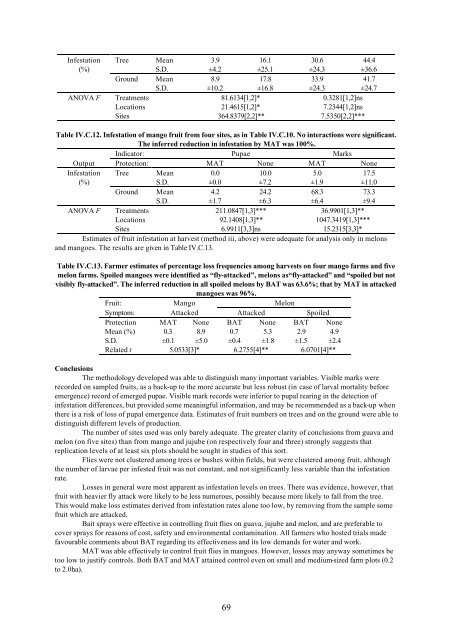“Key Informant Survey” of Production, Value, Losses and ... - DfID
“Key Informant Survey” of Production, Value, Losses and ... - DfID
“Key Informant Survey” of Production, Value, Losses and ... - DfID
Create successful ePaper yourself
Turn your PDF publications into a flip-book with our unique Google optimized e-Paper software.
Infestation<br />
(%)<br />
ANOVA F<br />
Tree Mean 3.9 16.1 30.6 44.4<br />
S.D. ±4.2 ±25.1 ±24.3 ±36.6<br />
Ground Mean 8.9 17.8 33.9 41.7<br />
S.D. ±10.2 ±16.8 ±24.3 ±24.7<br />
Treatments 81.6134[1,2]* 0.3281[1,2]ns<br />
Locations 21.4615[1,2]* 7.2344[1,2]ns<br />
Sites 364.8379[2,2]** 7.5350[2,2]***<br />
Table IV.C.12. Infestation <strong>of</strong> mango fruit from four sites, as in Table IV.C.10. No interactions were significant.<br />
The inferred reduction in infestation by MAT was 100%.<br />
Indicator: Pupae Marks<br />
Output Protection: MAT None MAT None<br />
Infestation Tree Mean 0.0 10.0 5.0 17.5<br />
(%)<br />
S.D. ±0.0 ±7.2 ±1.9 ±11.0<br />
Ground Mean 4.2 24.2 68.3 73.3<br />
S.D. ±1.7 ±6.3 ±6.4 ±9.4<br />
ANOVA F Treatments 211.0847[1,3]*** 36.9901[1,3]**<br />
Locations 92.1408[1,3]** 1047.3419[1,3]***<br />
Sites 6.9911[3,3]ns 15.2315[3,3]*<br />
Estimates <strong>of</strong> fruit infestation at harvest (method iii, above) were adequate for analysis only in melons<br />
<strong>and</strong> mangoes. The results are given in Table IV.C.13.<br />
Table IV.C.13. Farmer estimates <strong>of</strong> percentage loss frequencies among harvests on four mango farms <strong>and</strong> five<br />
melon farms. Spoiled mangoes were identified as “fly-attacked”, melons as“fly-attacked” <strong>and</strong> “spoiled but not<br />
visibly fly-attacked”. The inferred reduction in all spoiled melons by BAT was 63.6%; that by MAT in attacked<br />
mangoes was 96%.<br />
Fruit: Mango Melon<br />
Symptom: Attacked Attacked Spoiled<br />
Protection MAT None BAT None BAT None<br />
Mean (%) 0.3 8.9 0.7 5.3 2.9 4.9<br />
S.D. ±0.1 ±5.0 ±0.4 ±1.8 ±1.5 ±2.4<br />
Related t 5.0533[3]* 6.2755[4]** 6.0701[4]**<br />
Conclusions<br />
The methodology developed was able to distinguish many important variables. Visible marks were<br />
recorded on sampled fruits, as a back-up to the more accurate but less robust (in case <strong>of</strong> larval mortality before<br />
emergence) record <strong>of</strong> emerged pupae. Visible mark records were inferior to pupal rearing in the detection <strong>of</strong><br />
infestation differences, but provided some meaningful information, <strong>and</strong> may be recommended as a back-up when<br />
there is a risk <strong>of</strong> loss <strong>of</strong> pupal emergence data. Estimates <strong>of</strong> fruit numbers on trees <strong>and</strong> on the ground were able to<br />
distinguish different levels <strong>of</strong> production.<br />
The number <strong>of</strong> sites used was only barely adequate. The greater clarity <strong>of</strong> conclusions from guava <strong>and</strong><br />
melon (on five sites) than from mango <strong>and</strong> jujube (on respectively four <strong>and</strong> three) strongly suggests that<br />
replication levels <strong>of</strong> at least six plots should be sought in studies <strong>of</strong> this sort.<br />
Flies were not clustered among trees or bushes within fields, but were clustered among fruit, although<br />
the number <strong>of</strong> larvae per infested fruit was not constant, <strong>and</strong> not significantly less variable than the infestation<br />
rate.<br />
<strong>Losses</strong> in general were most apparent as infestation levels on trees. There was evidence, however, that<br />
fruit with heavier fly attack were likely to be less numerous, possibly because more likely to fall from the tree.<br />
This would make loss estimates derived from infestation rates alone too low, by removing from the sample some<br />
fruit which are attacked.<br />
Bait sprays were effective in controlling fruit flies on guava, jujube <strong>and</strong> melon, <strong>and</strong> are preferable to<br />
cover sprays for reasons <strong>of</strong> cost, safety <strong>and</strong> environmental contamination. All farmers who hosted trials made<br />
favourable comments about BAT regarding its effectiveness <strong>and</strong> its low dem<strong>and</strong>s for water <strong>and</strong> work.<br />
MAT was able effectively to control fruit flies in mangoes. However, losses may anyway sometimes be<br />
too low to justify controls. Both BAT <strong>and</strong> MAT attained control even on small <strong>and</strong> medium-sized farm plots (0.2<br />
to 2.0ha).<br />
69

















